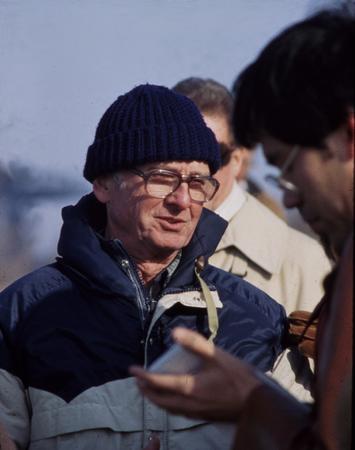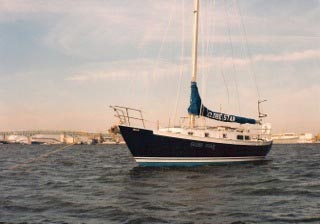
Many people ask, “What do geographers do?” I would suggest that Marvin Creamer’s life story is all you need to know about the practical application of geography, even though most of us will never be stuck in a horizonless Indian Ocean on a “sea of glass”, or try to navigate the ferocious Drake’s Passage. Ancient mariners may have been able to sail long distances without instruments, but it is difficult, tricky, and can be extremely hazardous. Only one person, New Jersey’s Marvin Creamer, has ever attempted to circumnavigate the globe this way. I had the distinct honor of interviewing Marvin Creamer for the thirtieth anniversary of his historic achievement. The 96 year old sailor and geographer also founded Rowan University’s geography department, and taught there for over three decades.
At 66 years old in 1982 (five years after his retirement), Creamer became the only person ever to sail around the world without any navigational aids, not even a watch. He had spent three years thinking about it, two years making practice runs and doing research on the possibility, and 18 months accomplishing it. Instead of a compass and sextant, his only navigational tools were his extensive knowledge of geography, an hourglass, and a lot of optimism.
 Creamer and his crewmates braved all manner of conditions over an 18 month period to accomplish the truly historic feat. He became an expert at celestial sailing, designating a “North Star” and triangulating his position off of it. Using this method he could keep within 1 degree of latitude and longitude, but this would not help him during the daytime or cloudy conditions.
Creamer and his crewmates braved all manner of conditions over an 18 month period to accomplish the truly historic feat. He became an expert at celestial sailing, designating a “North Star” and triangulating his position off of it. Using this method he could keep within 1 degree of latitude and longitude, but this would not help him during the daytime or cloudy conditions.
For navigation during daytime or overcast conditions, he needed to find other ways to determine latitude. He studied ocean currents, marine life, water color and temperature. These skills would be critical not only in stormy conditions, but also in calms under slate skies.. He used his encyclopedic geographic knowledge to — for example — glean vital information from a squeaky hinge by determining where a desiccating wind (that caused the squeaking) would originate from. Sailors can become disoriented the same way pilots become confused when they have no visual cues to reference. More than once Creamer found himself fogged in on a shipping lane, and shaken by the blaring fog horns of massive tankers nearby.
The biggest planning problem was how to get around Cape Horn. Scientists who had worked in Antarctica advised that maybe once a month clear skies would exist on the Cape. He would have to be able to navigate the world’s most treacherous waters blind. Not only were the currents savage, the winds were often gale force, with high waves and icebergs. It’s no surprise that the Drake Passage is known as a sailor’s graveyard.
The southern sky is also much cloudier on average that the northern hemisphere’s, which would add to the difficulty of navigating without instruments there. But Boy Scouts in New Zealand taught him how to use the Southern Cross and only a thin sliver of sky to find the Polar Point.
Marvin Creamer departed Cape May, NJ on December 21, 1982 under overcast skies with temperatures in the teens and an advancing cold front. He arrived in Cape Town South Africa on March 31st , 1983, and spent 8 weeks there fixing the boat and getting rest. The next leg was crossing the Indian Ocean in winter time to get to Tasmania. Upon arrival in Hobart, the fishermen there were so impressed that he could make landfall in such harsh conditions on the dark and desolate coast that they threw him 36 parties in the 6 weeks he stayed. Heading back down the Derwent River, 90 mph winds tossed the Globe Star upside down. His steel hulled boat with its shortened mast, built for this trip., sustained only minor physical damage, but an ill crew member needed to be dropped off in Sydney.
On the way he was trapped for two days by Bomboras — dangerous eddies over hidden reefs of rocks — crashing around him (he described them as 'going off like geysers' all around him), in one of the journey's most terrifying episodes. Finally, after navigating through a minefield of rocky outcrops, he made it through to the East Australian Current and Sydney. After stopping in New Zealand, it was off to Cape Horn and Drake’s passage.
Sailing through the Drake was a wild adventure with winds and currents so strong that the boat could never be turned more than 15 degrees without it feeling and sounding like it was being hit with mortar fire. During the 600 mile passage his tiller broke and his shoulder was dislocated. Creamer worked furiously to cut loose his camera mount and build a makeshift steering shaft.
After the near catastrophe he turned north towards the Falklands, which are notoriously difficult to sail, due to their remoteness and constantly changing conditions. In addition to the geographic challenges, he had entered a sensitive area that had seen war only months before. The British were still on high alert. When Creamer saw British fighters overhead (and they spotted him as well), he looked for a place to make port, and unknowingly chose a top secret British base, where he immediately found himself under house arrest. But after a little dialogue his captors treated him royally, and provisioned him for the final leg of his incredible journey. Marvin arrived in Cape May, NJ safely on May 17, 1984.
Photos by Ralph Harvey
Chuck McGlynn is an assistant professor at Rowan University in Glassboro, New Jersey. The university is planning a series of major events next spring to commemorate Creamer's achievement, including a planetarium experience where attendees will be able to “travel with Marvin and the Globe Star” around the world. An interactive map experience will allow users to select any point along the journey for a display of the Globe Star journey's date, time, longitude, average air and water temperatures, prevailing winds and sea-current.












